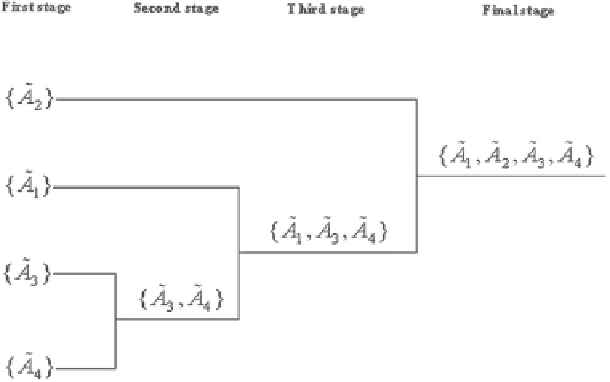Information Technology Reference
In-Depth Information
Fig. 2.2
Classification of the enterprises
A
j
(
j
=
1
,
2
,
3
,
4
)
μ
R
:
X
×
Y
→[
0
,
1
]
,
v
R
:
X
×
Y
→[
0
,
1
]
(2.114)
and
≤
μ
R
(
,
)
+
v
R
(
,
)
≤
,
(
,
)
∈
×
0
x
y
x
y
1
for any
x
y
X
Y
(2.115)
Definition 2.17
(Bustince 2000) Let
R
be an intuitionistic fuzzy relation. If
(1) (
Reflexivity
).
μ
R
(
x
,
x
)
=
1
,
v
R
(
x
,
x
)
=
0, for any
x
∈
X
.
(2) (
Symmetry
).
μ
R
(
x
,
y
)
=
μ
R
(
y
,
x
),
v
R
(
x
,
y
)
=
v
R
(
y
,
x
)
, for any
(
x
,
y
)
∈
X
×
Y
,
then
R
is called an intuitionistic fuzzy similarity relation.
Definition 2.18
(Xu et al. 2011) Let
α
=
(α
1
,α
2
,...,α
n
)
be a vector. If all
α
i
=
(μ
α
i
,
v
)(
i
=
1
,
2
,...,
n
)
are IFVs, then we call
α
an intuitionistic fuzzy vector,
α
i
T
as the transpose of
T
and denote
α
α
, where
α
is a
n
-dimensional column vector.
Definition 2.19
(Xu et al. 2011) Let
α, β
∈
X
1
×
n
,
where
X
1
×
n
denotes the set of
intuitionistic fuzzy vectors. Then
α
·
β
=
(
max
{
min
{
μ
α
i
,μ
β
i
}}
,
min
{
max
{
v
α
i
,
v
β
j
}}
)
n
∨
n
∧
=
(
1
(μ
α
i
∧
μ
β
i
),
1
(
v
α
i
∨
v
β
j
))
(2.116)
i
=
i
=
is called the inner product of
α
and
β
, where
∨
and
∧
denote the max and min
operations respectively.
Definition 2.20
(Xu et al. 2011) Let
α, β
∈
X
1
×
n
,
if
α
·
β
=
(
0
,
1
)
or
(
0
,
0
)
. Then
we call that
α
is orthogonal to
β
.

Search WWH ::

Custom Search